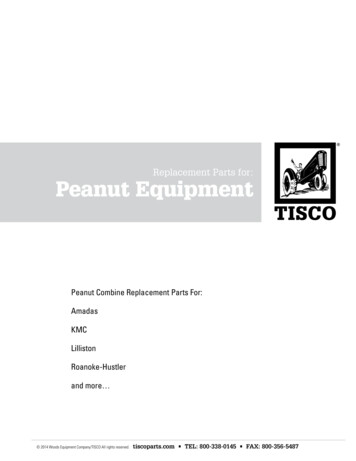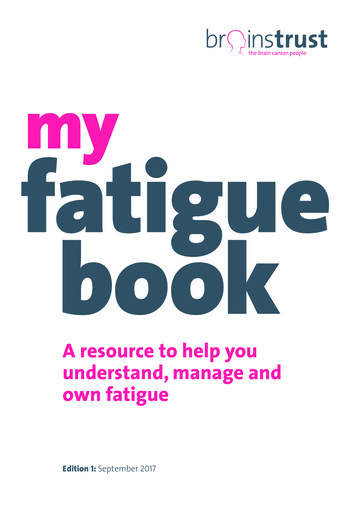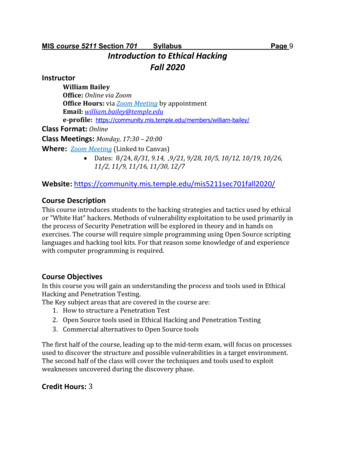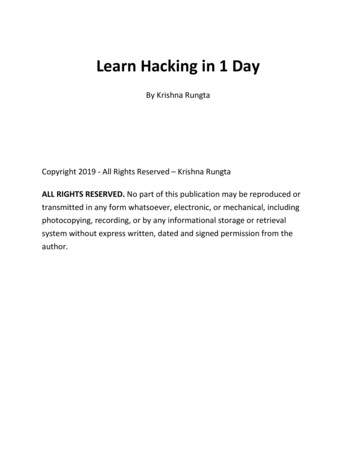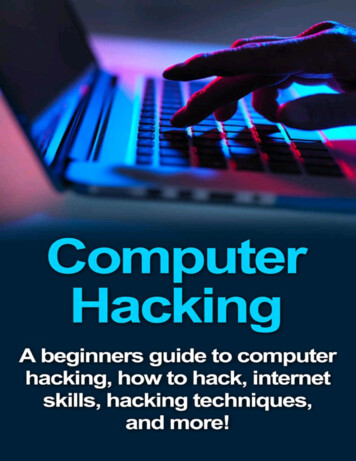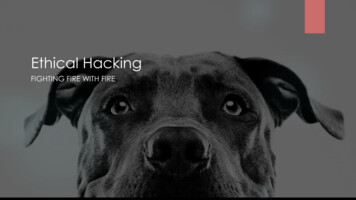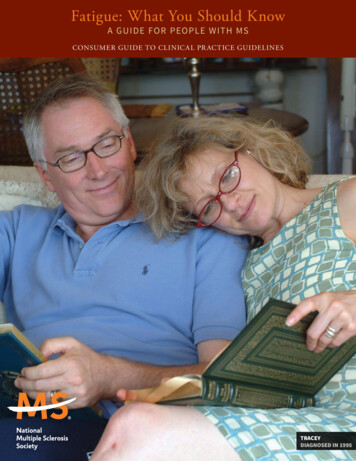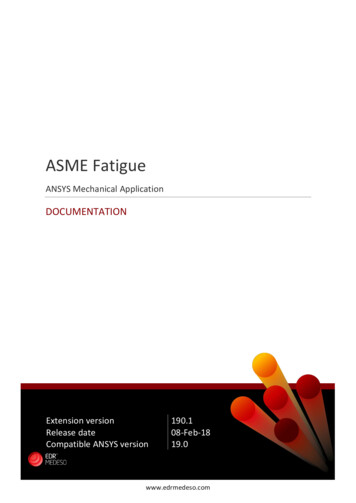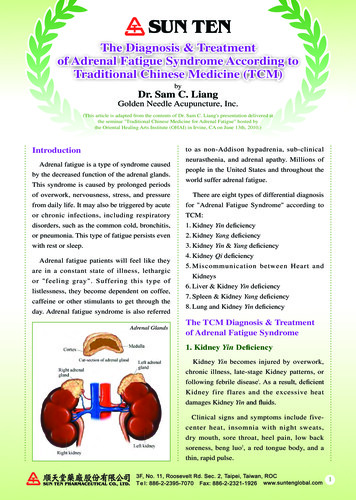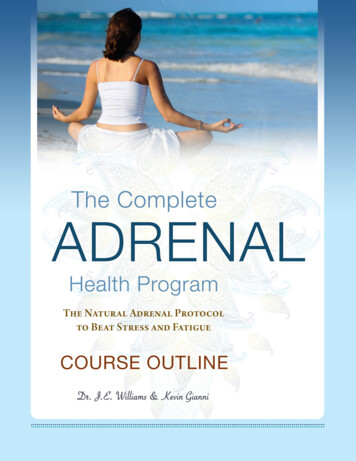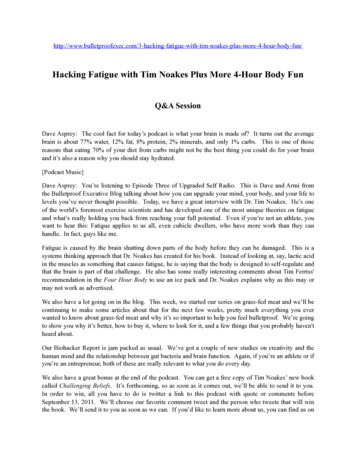
Transcription
ith-tim-noakes-plus-more-4-hour-body-fun/Hacking Fatigue with Tim Noakes Plus More 4-Hour Body FunQ&A SessionDave Asprey: The cool fact for today’s podcast is what your brain is made of? It turns out the averagebrain is about 77% water, 12% fat, 8% protein, 2% minerals, and only 1% carbs. This is one of thosereasons that eating 70% of your diet from carbs might not be the best thing you could do for your brainand it’s also a reason why you should stay hydrated.[Podcast Music]Dave Asprey: You’re listening to Episode Three of Upgraded Self Radio. This is Dave and Armi fromthe Bulletproof Executive Blog talking about how you can upgrade your mind, your body, and your life tolevels you’ve never thought possible. Today, we have a great interview with Dr. Tim Noakes. He’s oneof the world’s foremost exercise scientists and has developed one of the most unique theories on fatigueand what’s really holding you back from reaching your full potential. Even if you’re not an athlete, youwant to hear this: Fatigue applies to us all, even cubicle dwellers, who have more work than they canhandle. In fact, guys like me.Fatigue is caused by the brain shutting down parts of the body before they can be damaged. This is asystems thinking approach that Dr. Noakes has created for his book. Instead of looking at, say, lactic acidin the muscles as something that causes fatigue, he is saying that the body is designed to self-regulate andthat the brain is part of that challenge. He also has some really interesting comments about Tim Ferriss'recommendation in the Four Hour Body to use an ice pack and Dr. Noakes explains why as this may ormay not work as advertised.We also have a lot going on in the blog. This week, we started our series on grass-fed meat and we’ll becontinuing to make some articles about that for the next few weeks, pretty much everything you everwanted to know about grass-fed meat and why it’s so important to help you feel bulletproof. We’re goingto show you why it’s better, how to buy it, where to look for it, and a few things that you probably haven'theard about.Our Biohacker Report is jam packed as usual. We’ve got a couple of new studies on creativity and thehuman mind and the relationship between gut bacteria and brain function. Again, if you’re an athlete or ifyou’re an entrepreneur, both of these are really relevant to what you do every day.We also have a great bonus at the end of the podcast. You can get a free copy of Tim Noakes’ new bookcalled Challenging Beliefs. It’s forthcoming, so as soon as it comes out, we’ll be able to send it to you.In order to win, all you have to do is twitter a link to this podcast with quote or comments beforeSeptember 13, 2011. We’ll choose our favorite comment tweet and the person who tweets that will winthe book. We’ll send it to you as soon as we can. If you’d like to learn more about us, you can find us on
Twitter. You can get into touch on Facebook or you can sign up for an email or newsletter. There arelinks to all of those on bulletproofexec.com.So Armi, let’s get going. Let’s talk about what biohacks you've working on this week. What are youdoing?Armi Legge: Well, I’ve got a triathlon this weekend, so one of the things I’ve been doing is changing outmy taper, which is when you reduce the amount of training before a race. And what I have been doing isI’ve been inserting something called Tabata Intervals and I’ve been doing some very specific swimtraining that I’ll probably be blogging about sometime soon. And I’ve been also changing my diet a littlebit and instead of carb loading earlier in the week, I’m tweaking what kinds of carbs I'm eating, what kindof fats I'm eating, and a lot of other stuff. And also, I’m changing my weight training protocol in the leadup to the race. So, we’ll see how that all works out this weekend. What about you, man?Dave Asprey: Well, we had a couple of neat things going on. I just got back yesterday from BurningMan, the Arts Festival that’s in the middle of the desert. And I had the crazy schedule. I flew fromVictoria to San Francisco to London to Copenhagen to Sweden to London to San Francisco to Las Vegas,all in 11 days and then I went to spend several days in a really hostile desert at high altitude with very lowhumidity and huge amounts of dust and very little sleep and pretty much a perfect recipe for getting sick.And because of the Bulletproof techniques that I have been using, I was less sick than most of the peoplewho didn’t do all the crazy traveling before going to the desert and in fact, I felt really good the wholetime by sticking to the Bulletproof Diet and by taking the right supplements.The second thing I’m doing that’s extremely exciting is that last night, I just plugged in the BrainMasterAtlantis, a two-channel clinical grade EEG machine, which is going to let me do even more of the type ofbrain hacking and neurofeedback that I had been interested in doing. So, over the next few weeks, I’mhoping to get up to speed with this system and to be able to share some results of what I learned and whatI’m able to achieve with it.Armi Legge: Well, I can’t wait until those articles to come out, man. That’s going to be awesome. So,are you ready to get on to the listener Q&A and see how people clicked up this week?[Dave Asprey]: Yeah, let’s do it.Armi Legge: Cool! This is the Listener Q&A, and the first question comes from Michael, “Great site,Dave, but I have one question. Is it more cost effective to go for the Paleo Pemmican or the CollagenPowder? As with the Paleo Pemmican, you get the whole shebang with collagen too, while collagen isjust by itself. What for you personally gave the most benefits and is it overkill to take both?Dave Asprey: They’re different. If you only take one, your best bet is the Paleo Pemmican because it’sgot a bunch of stuff in it that goes beyond just Collagen. It has some healthy fats in it, some of the MCTs.But it also has Lactoferrin, which is basically the immune activating part of mother’s milk. It’s asubfraction that comes out in some forms of way, but it doesn’t have the milk allergens in it that peopleare allergic to milk have. So it’s more immune stimulating and it’s closer to like a meal replacement or ameal supplement sort of thing.If you’re interested in the hydration effects and in joints and skin and all, and only those things without allthe other benefits, you could go a straight Collagen. I would say the Paleo Pemmican is more wellrounded and it’s designed to have the right fat-protein ratio that something more like a Pemmican would
have. I’m also pretty excited to announce that in the next few weeks, we’re hoping to come out with anew version of a protein powder that I personally formulated in order to have even more immunestimulating properties different ones than the current Paleo Pemmican, but something that would go reallywell as meal replacement and something that will be more cost effective and have amazing benefits.Armi Legge: I can actually attest that. One of the things I’ve been playing around is trying out the PaleoPemmican for recovery between workouts and it works amazingly well.So, this next question comes from Rachel, “It seems like you take a ton of different supplements. I waswondering if you could outline exactly which ones you take and why?”Dave Asprey: You know, I can. If I’m doing a certain thing for my body, I might take a set ofsupplements. If I am trying to do something else, I might take different ones. If I get less sleep, I’ll takemore of one, less of another. So, there are two approaches to supplementation. One is that you prettymuch take the same thing every day, hopefully at about the same time, and that works, but it also meansthat your body becomes acclimated to it, so you’re better off to take some breaks with your supplementsto prevent an in between process called hormesis. What I did when I’m really trying to heal some thingsin my body and I’m trying to be at my fullest performance, I did a spreadsheet and figured out that if Ihad the time and energy and focus to do it, I would take about 187 pills a day, which I think is like twomore than Ray Criswell. I’ll be publishing that spreadsheet some other time. However, I take somethingcloser to about forty or fifty pills a day, many of which are large size molecules that just take several pillseach.So, yeah, I can do this and what I will do is very much like we did for the Bulletproof Diet. I’ll show youa diagram that says, “For this thing to be achieved for you, you’ll need to take these vitamins, and theseones are more important than these other ones." Because you could spend hundreds of thousands ofdollars, in fact, well, you know, I have spent more than a hundred thousand dollars on vitamins over theyears, but it’s most important that you realize where you get the most bank for your buck and you startwith the biggest things that don’t cost a lot and over time – or because you have specific health concerns,you start tweaking and adding more expensive molecules that make a difference specifically for you.Armi Legge: Are there any supplements that you do recommend to take regularly without break such asvitamin D?Dave Asprey: Yeah. I think D is one of those things that you pretty much need to take it without breaksunless you’re spending a lot of time in the sun with your clothes off and no sunscreen. Most peopleactually wear clothes when they’re out in the sun, so even if you’re out, you know, you probably ought tobe taking your D every day, but you might reduce the volume based on what you do. I think for peoplewho attended Burning Man last week, a lot of them actually were in the sun with very few clothes on, sofor those people, maybe they did skip their vitamin D and it was okay. Other than that though, we don’twear togas outside most of the time.Vitamin C is another thing. You should take it most of the time, but you should take some breaks from it.If you take it regularly all the time, and then you quit it for two days, you’ll actually get bleeding gumsand it’s basically a version of scurvy that comes from withdrawing the high levels of vitamin C thatyou’re used to and you'll cure yourself in about two days as your body reallocates the vitamin C that’s inyour body, but you do want relatively high levels of that on a regular basis because it helps you formhealthy collagen in your skin and it helps your liver make its primary detoxifying enzyme, which is calledthe glutathione.
Armi Legge: Cool! And we also have a Lipoceutical Glutathione too, don’t we? That’s pretty beneficial.Dave Asprey: Okay, that’s a good point. If you’re doing something that’s particularly toxic or you’reeating foods that aren’t so good or if you’re cutting back on sleep, which actually reduces your ability toremove toxins, or if you’re traveling, that’s something that I do take because your liver can only makeglutathione if it has vitamin C plus N-acetyl-cysteine and several other cofactors. So, you can prettymuch bypass your liver’s production of that all together by just taking glutathione that enters your bloodstream directly through the wall of the gut, which is a pretty neat little hack for molecules that otherwiseare digested. That’s not, however, something that I recommend you take every day unless your liver isweak. It’s something you should take when you don’t get enough sleep or when you travel or whenyou’re stressed or when you need an exercise recovery very quickly. I take a bottle of it with mewhenever I travel and I take it before I get on a plane and after I get off the plane and before I go to sleepin a hotel room.Armi Legge: Sounds smart. This next question is from Kent, “What is your take on animal research thatshows being on a high-fat diet is strongly linked with decreased insulin sensitivity?Dave Asprey: I think that’s one of the elegant beautiful links about the human body and that shows thatit’s a well-run system. And it makes sense that if you are eating a high-fat diet without enough carbs thatyou get decreased insulin sensitivity and that’s because the carbs that your body was expecting areactually necessary, first and foremost, for the brain. So, this healthy insulin sensitivity decrease is causedsimply by your body saying, “The brain gets first dibs on glucose.” And the rest of the body, well, you’regoing to have to learn to live on fat, which is a very healthy thing to do anyway. This is not unhealthy. Ialso would point out that a lot of that research is not looking at specific fats. They’re saying, “high-fatdiet”, and I’ll tell you, a high hydrogenated fat or a high omega-6 fat diet is going to cause decreasedinsulin sensitivity because it’s going to affect your cell wall flexibility and you won’t be able to expressyour insulin receptors through the cell walls. So, anytime someone says a high-fat diet does this, it’spretty much like saying a high-food diet does this because there are gazillion types of fats. And if theydon’t say which fats and where they came from, it’s not a valid study.Armi Legge: I agree. Yeah. One of the other problems I think common with these things is people thinkthat that’s permanent or that is going to lead to type 2 diabetes and like that study we talked about earlierwhere they said it causes type 2 diabetes, that’s not true. It causes mild insulin resistance and that’scompletely temporary and goes away the second you start eating more carbs. So, it’s not you’re going toget fat from eating high-fat diet.Dave Asprey: Yeah. So, decreased insulin sensitivity is just fine as long as it’s not permanent just likeyou’re saying, so I have zero concerns there. And if this was a major issue after many, many years ofeating the Bulletproof Diet and over the years, I’m strengthening it and improving it, you would think thatI would have like massive insulin sensitivity, but it’s actually better than it was years ago. I used to havebig problems with blood sugar swings. I don’t know. In fact, last week, just to confirm it for myself, Ibought a ten dollar blood glucose meter and I haven't played with one in ten years just to see, and whatyou know? I don’t see there are problems here even though I eat an incredibly high-fat diet.Armi Legge: Yeah, sounds good. This next one is from Dave strangely enough, a different one, “If thegoal is fifty to sixty percent of calories from healthy fats, and I’m assuming he’s talking about theBulletproof Diet here, that implies that healthy fats are full of nutrients. Could you expand on this? Also,what keeps fats down the gullet from becoming fat around the waistline?”
Dave Asprey: I love it when people use the word “gullet” in their nutritional talking. These are usuallypeople who are maybe anorectic or who have like some kind of weird food aversions going on. Becausethe bottom line is that’s, I would say, a kind of some charged language there, which is kind of funny. Iwould say it’s the same thing that keeps vegetarians who put cucumbers down their gullet from gettingfat. So let’s say, whatever. Nice attempt on the question there, Dave.But there are nutrients that are in butter, conjugated linoleic acid, medium chain triglycerides, not thatmany of them in butter actually, stearic acid, and all of those are nutrients, in case that’s not really clear topeople. However, there are also some trace nutrients and vitamins in it as well. Vitamins A, a little bit ofD, E, and K are also present in good amounts in things like butter. Animal fats are full of all kinds ofother things, different links fatty acid chains, some of which if you eat grass-fed beef, the bacteria in thestomach of the beef make, I believe, there are 17 chains, I could be wrong on the length, fatty acids thataren’t found otherwise that are biologically active. So, the idea that fats are empty calories as the FDAwould tell you is actually completely wrong. They are no more or less empty than other foods. I wouldsay that fat itself is a nutrient and that’s perfectly okay. We run on that stuff.Armi Legge: Yeah, something also I’d like to add to that is that a lot of people look at vegetables, they’recolorful and they’re all bright and shiny and basically and everything, and they think like those are somekind of magical multivitamin when a lot of people don’t realize that even if they’re eating a lots ofvegetables, they’re eating not enough fat. They’re not gonna be absorbing those vitamins and nutrientsbecause they are fat soluble. So, the vitamins and minerals and nutrients that are in high-fat foods areactually more bioavailable to your body too.Dave Asprey: In fact, I’m glad you said that. My take on vegetables is that they’re most effective ascarriers for more butter in your diet. If you’re starving yourself by taking a cucumber and, you knowdehydrating it or something and not putting any fat on it and eating the thing, you’re not only not gettingall the benefits of it, you’re basically giving your body food that is not high performing in any way, shape,or form. This is the scam about the ANDI, aggregate nutrient density index and the whole foods it isrunning right now, it just makes me itch. And the reason for that is that they’re using water as part of theequation here. So, they’re saying, “Oh, look, you know, the, the nutrient density here is really goodbecause as a percentage of calories, it’s great." But the problem is that if you buy watermelon, it’s almostall water. It’s not nutrients of any form, yet they would say, because of that, this has a high nutrientdensity as a percentage of calories. That’s BS. I will any day of the week eat a pound of butter or apound of grass-fed meat over a pound of watermelon and I would challenge anyone to do the watermelonevery day for, let's say, a month and look at what it does to their health even though it has a higher ANDIscores than grass-fed meat.Armi Legge: Agreed. And just another thing to add on this is that a lot of the nutrients in vegetables areactually not technically nutrients such as carrots. For a long time, I was thinking I was getting all theVitamin A I needed by eating tons of carrots, I still like carrots, I still eat them for carbs. They’re great.But you can’t just rely on this because the carrots don’t actually contain Vitamin A. They contain betacarotene, which is very poorly converted into Vitamin A in the body, so they have literally had thesegroups around the world that were showing signs of Vitamin A deficiency even though they are taking farmore than the recommended daily amount, but it was from vegetables because it wasn’t a bioavailableform like you'd get from animal products like grass-fed butter.Dave Asprey: I completely agree.
Armi Legge: Cool. So, this next one is from Ronn, and he has two parts to the question, “Hi, Dave. I’mnew to your site and all the fascinating information here. So, if my question has already been asked andanswered elsewhere, I haven’t found it yet. One, I’ve had dairy allergies since childhood. Could Isubstitute Extra Virgin coconut oil for the butter in Bulletproof Coffee? If not, any other suggestions onreplacements for dairy?” And why don't you just go ahead with that before we go on to the next one.DA: Sure. So funny enough, I’ve also had dairy allergies since childhood, although they weren’tdiagnosed until a little bit later in life. If I eat cheese or even eat something that's cooked with a couple oftablespoons of milk, I get swollen joints. This has been a problem forever. So you can usually handlegrass-fed butter because there’s very, very little protein in it. And you don’t mention if it’s dairy proteinor dairy sugar lactose, that’s your problem. But I’m guessing, it’s casein or the protein that’s there.Butter is low casein. If that’s still a problem for you, you can actually buy grass-fed ghee, which isclarified butter. Clarified butter that’s made properly has zero protein in it. It is just this healthy saturatedand a few of the slightly less saturated fats that are in butter. And people who are allergic to dairy canalmost always handle ghee and actually, they eat it, and they can’t get enough, like they usually over eat itto the point that they’re nauseous because their body is like, “Oh, thank God, I finally got these fats Ineeded.” I’ve seen that happen over and over. So, I would really try ghee. It also tastes kind of likecaramel in coffee. It’s awesome in coffee. You could use Extra Virgin Coconut Oil in Bulletproof Coffee.I do that sometimes, although it tastes better and it blends better if you do straight unsalted grass-fedbutter plus maybe 30 percent of the fat as Medium Chain Triglyceride oil that has the most effectbiologically and it tastes best with the best head of foam on it. You could also do canned coconut milk inthere, which tastes really good and it frosts very nicely as well. Coconut milk in ghee would give you abeautiful head of foam on Bulletproof Coffee.Armi Legge: Cool. His next question is, “I’m a 95% to 99% raw food vegetarian, a vegetarian for 35years now, raw foodie for four years. I eat eggs occasionally, and can tolerate small amounts of raw goatmilk cheese once in a while. Is raw goat milk cheese evil? Is there a place for me in the Bulletproof Dietplan?"Dave Asprey: I hear this pretty often from vegetarians, particularly vegans, and I can see there isprobably a couple of dozen vegetarians or vegans who after talking with me for a while have actuallychanged their diet to include at least some amounts of meat. There’re a couple of questions on this.Eating eggs occasionally is really important. I’m saying this from the perspective of someone, when Iwas 300 pounds, I did go for a raw diet. I did it for about nine months. The first two or three months, Iwas raw vegetarian. The first four to six weeks, you feel really good because you’re eating a lot less ofthe type of toxins that your body is used to eating, which usually come from grain-fed meats andMycotoxins in normal food products. So, you get cleaned out, but then you start running short onnutrients, particularly the healthy fats that your body needs.So, what I did is I added raw meat into my diet. So, I did raw eggs, raw steak, raw chicken, raw turkey,and raw fish in the form of sushi. There are healthy ways to do this and what you do is you sterilize themeat, needs to be pastured meat, you sterilize it in a mixture of ten drops of Lugol’s Iodine in a bowl ofwater. When you do that, you’re killing anything that’s on the surface of the meat. You can also ozonatethe meat if you have an ozone machine that’s capable of making ozonated water. So, if you do that as araw food person, you’re still raw, but you’ll find that an ounce of meat is profoundly – just profoundlyenergy providing. You'll feel so good and it also fills you up like a full steak wouldn’t fill up someone.So, if you have the time and energy to be a raw foodie, adding raw meat is actually less work thanpreparing most raw food dishes like blending cashews after you’ve soaked them and all that, it’s lesswork. I would add three egg yolks a day, you can eat the white because you’re probably protein deficient.I tell a lot of people to toss the whites, eat the yolks. I love friends who eat egg white omelets like TimFerriss says because I get to eat the yolks. I love that. Raw goat milk cheese, it all depends on whatbacteria and fungus made the cheese. The odds are it probably wasn’t a very healthy one and that itmakes particularly some toxins in it. You might be better off with nut cheese that’s not fermented.And for the question, is there a place for you in a Bulletproof Diet plan, the Bulletproof Diet is aboutbeing 100% optimized and having the most energy and resilience you can possible get from all variables.
So, from that perspective, well, no. There isn’t a place for you in the Bulletproof Diet plan becauseyou’re making the choice to be a vegetarian, which by definition means that you are going to be not as faron that curve as it is possible. However, there is a place for you in the Bulletproof Diet plan given theconstraints that you’ve placed on yourself and that you can optimize that as much as possible and to thatextent, yes, if you adopt as much to the Bulletproof Diet like the percentage of calories and all. As avegetarian if you eat enough eggs, you can probably pull it off, especially if you cut out soy. You’ll atleast be as optimized as you can be.I would point out, however, that the Bulletproof Diet has a lower ecological footprint than any vegetariandiet known to man. If you eat only two pounds of grass-fed steak every day as your protein source, twopounds is quite a lot by the way, you’re killing .7 animals per year. And as a system’s thinker, I’mlooking at the system that includes the soil, includes soil organisms, insects, rabbits, bunnies, mice,snakes, lizards, grasshoppers, and the like, every time you eat that, that bowl of rice or legumes, usually atractor did cut that down and if you walk around behind the tractor, you can collect bagfuls of deadanimals. Anyone who has lived in the farming community knows about tractor kills as well as thedestruction of top soil that comes even from organic farming. You can with the right organic farmingpreserve soil, but it still is a very big challenge and most farming isn’t.So if you’re trying to be a vegetarian to save the planet, man, it’s time to be a Bulletproof Diet guy and toincorporate locally grown grass-fed meat that was raised on land that wasn’t agriculturally suitable forfarming. That’s what I do. I kill less animals than any vegetarian I know on a yearly basis.Armi Legge: I’d also like to add that the moral and ethical and political reasons behind vegetarians arealso pretty flawed. We are obviously not going to go into a whole podcast about that. We may in thefuture because that is an interesting topic, but if you want to learn more about that, you ought to check outthe book, the Vegetarian Myth, but it’s very eye opening for a lot of vegetarians. So, if you want to checkthat out, it will be great. We will have a link for that along with everything else we talked about in theshow notes.Cool! So, that does it for the Listener Q & A of this episode. If you have questions for the podcast, youcan contact us on Twitter, Facebook, or in the Contact form in the Show Notes of this episode. We’ll alsopick through the comments to find good questions, so if you leave a comment in one of our articles, it’llprobably make its way into the podcast. Now, we’re going to move on to our exclusive interview with Dr.Tim Noakes.
Podcast InterviewArmi Legge: Hey, folks. It’s Armi Legge. And today, we have Tim Noakes, the author of the Lore ofRunning. He is a Sports Research scientist. He is the head of the Exercise Science and Sports MedicineResearch Unit at the University of Cape Town. He’s run over 71 marathons and ultra-marathons. He’sregarded as one of the top experts in sports efficiency and performance. I think I just said he wrote theLore of Running, which is one of the definitive books on running and has some extremely unique ideas.Tim, thank you so much for coming on.Tim Noakes: My pleasure, thanks for having me, Armi.AL: Cool. So the thing I wanted to talk about today mostly was your theory of the Central GovernorFatigue Theory, and could you explain exactly what that is?Tim Noakes: Yeah! To give you some background, when I started in exercise sciences in 1981, thetheory which was popular then and probably still is popular is that when you exercise, the reason why youget tired is because your muscles run out of oxygen or glycogen or something else and they then refuse towork, and that’s how fatigue occurs. And over the period of 25 years or so, I realized the problem withthat model is it doesn’t include the brain. And so, it’s a brain-less model. And the reality of the humancondition is that the brain is there to make sure that we don’t get into trouble and it regulates our behavior.As a consequence of the research we did, it came to me that in fact, what you have during exercise is thatthe brain is regulating the system to make sure that you don’t run into trouble. So, the Central Governormodel simply says that during exercise, the brain is receiving information from all parts of the body and itmodifies your behavior. It slows you down or speeds you up in response to all those inputs. As aconsequence, when you finish the exercise without collapsing catastrophically as it happens according tothe other model, so what we’ve done is we've just said that exercise is a controlled behavior and it’scontrolled by the brain and the control starts the instant you start the exercise, the brain has alreadycalculated what is safe for you to do under the prevailing conditions and it then shepherds you to thefinish, making sure that you don’t run into trouble. And that’s the idea.Armi Legge: So, if somebody started having a flare in the middle of a run and their legs start to seize upand really hurt, that would be more of a neurological response by the brain to try and make sure damagedo not occur to the legs?Tim Noakes: Yeah, and I’ll go even further than that all the symptoms you have during exercise aregenerated by your brain. They're unique to you, and they may be completely different to any symptomsanyone else has. So, we all assume that we feel the same sensations and symptoms during exercise, butthat is not proven. My view is that the sensations of discomfort are the way the brain regulates theperformance. The symptoms are utterly completely illusory. They are generated by the brain and theyhave nothing to do with the state of the body at that time. They only are related directly to how close youare to the finish. So, anyone who’s run enough or exercised enough in competition knows that yoursymptoms of discomfort arise as a function of how close you are to the finish, and it doesn’t matterwhether you run ten miles or hundred miles.
in the muscles as something that causes fatigue, he is saying that the body is designed to self-regulate and that the brain is part of that challenge. He also has some really interesting comments about Tim Ferriss' recommendation in the Four Hour Body to use an ice pack and Dr. Noake
